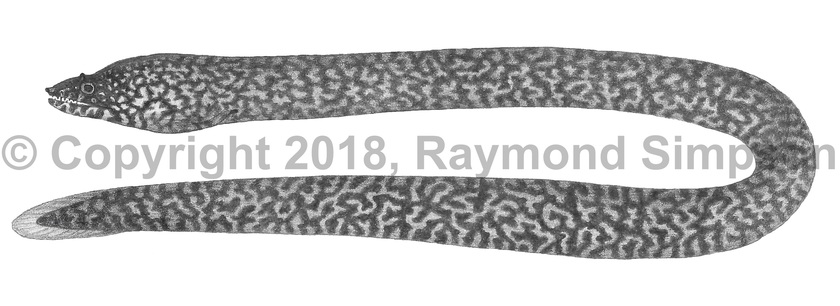
Common Name
Marbled Moray
Year Described
Lesueur, 1825
Identification
Body small and compressed. Low dorsal and anal fin-folds restricted to the tail. Trunk a little shorter than tail. Head tapers anteriorly to blunt snout. Jaw closes completely. Multiple rows of fangs in upper jaw: an outer row of small outer teeth, an inner row of larger canines, and a median row of canines. Vomer with a row of teeth. Lower jaw with an outer row of small pointed teeth and an inner row of larger fangs. Anterior nostril is a small tube. Rear nostril an external opening above upper margin of eye. No pore near posterior nostril. Eye large. Throat region grooved. Gill opening a simple slit. Tail tip hardened.
Color
Body chocolate to medium brown with pale whitish rosettes and/or marbling on the body. The markings can be distinct or almost invisible depending on age or mood. The head always has white spotting, especially on the lower jaw, and white spots centered on the head pores. Eye is yellowish speckled with black. The tip of the tail and fin-folds are golden yellow.
Size
Maximum size to 29cm TL.
Habitat
Inhabits coral and rocky reefs from 1-230m.
Range
Southern Florida, the SE Gulf of Mexico, the Caribbean Sea, to eastern Brazil. Also Bermuda.
References
Böhlke, E.B. 2002. Muraenidae (pp 700-718). In: Carpenter. 2002. The living marine resources of the Western Central Atlantic. Vol. 32: Bony fishes part 1 (Acipenseridae to Grammatidae). FAO Species Identification Guides for Fisheries Purposes. American Society of Ichthyologists and Herpetologists Special Publication No. 5.
De Castro, M.S., & A.C. Bonecker. 2005. Leptocephali collected off the eastern coast of Brazil (12–23 S). Zootaxa, 935(1), 1-28.
Other Notes
The only other species of small moray with the fin-folds restricted to the tail is Anarchias similis which has a pore adjacent to the posterior nostril, and non-overlapping vertebral counts (Böhlke, 2002).